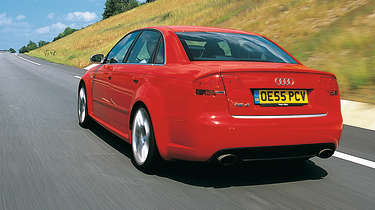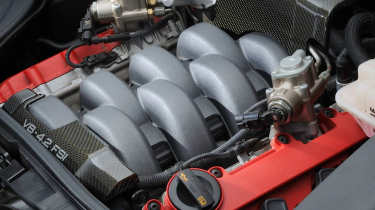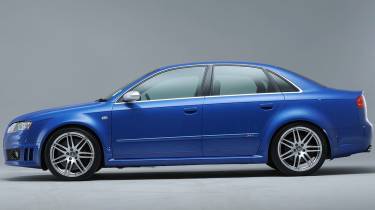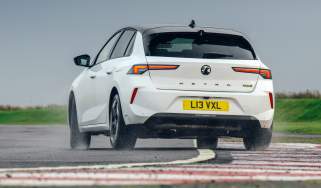Audi RS4 (B7, 2006 - 2008): a V8 supersaloon benchmark
Still the iteration by which all others are measured, Audi's second RS4 surprised us all with its exceptional engine and handling when it was launched in 2006
The B7 RS4 is an anomaly. When it arrived in 2005 there was nothing new on the surface. We’d seen four-wheel-drive, muscle-bound Audi RS products before, but the B7 was sewn from different DNA than its forebears. The Lamborghini Gallardo steering wheel is the first hint of its intentions. The rev counter, with red paint starting at 8250rpm, is the second. The final revelation comes when you take the RS4 to the edge and it gives back with supreme control and interaction. It all feels decidedly ‘un‑Audi’.
Conceived at a time when supersaloons came in all manner of forms, from the supercharged V8 Mercedes E55 AMG to the V10 E60 M5, Audi settled on a naturally aspirated 4.2-litre V8 for the B7. The 414bhp unit has a hunger for revs but also offers breadth and range, pulling hard no matter where you slot the ball-topped gearlever – it’s no surprise that the motor found a home in the R8 a couple of years later. Even in 2024, this RS4 is not to be messed with, dispatching the 0-62mph sprint in 4.7 seconds.
> Audi R8 4.2 FSI V8 quattro (2007 - 2015): review, history and specs of an icon
More reviews
Group tests
In-depth reviews
Reviews
But the raw performance is just one element that drives home the B7’s brilliance, a supplement to the wonderful rhythm and balance that seems to be there no matter which road you point it at. The contemporary M3, the E46, is more expressive and perhaps even more exciting, but the RS4’s compliance and monstrous traction invite you to dig deep into its ability. The chassis will dance to your tune with fine tweaks of the throttle, and while smokey slides are off the menu, the trade-off is indomitable performance in all conditions. With most of today’s supersaloons adopting four-wheel drive to pull a similar trick, the B7 was in some sense ahead of its time.
Buying guide
Today, a B7 is a solid buy. Leggy examples start from around £18,000, but values are rising – expect to pay over £20,000 for a well-maintained sub-60,000-mile car. All RS4s are equipped with a six-speed manual gearbox that has no trouble coping with the loads put through it, with even early examples proving largely fault-free.
Engine
The motor was also built to a high standard, but trundling around at low revs can allow oil to gather in the inlet tract, leading to carbon build-up and blue smoke from the tailpipes. Best to nudge that high-reaching red line when you can, then. Some RS4s can suffer from coil pack failure, too, resulting in a misfire. This can prove more costly if neglected, with the unburnt fuel potentially damaging one of the car’s two catalysts.
The RS4 can also suffer occasional coil-pack failure, so beware of misfires. The engine management warning light should alert the driver to this but doesn’t always do so. The actuators for the exhaust bypass valves can seize up too, so check you get the right rush of sound in Sport mode.
Audi’s quattro system is pretty robust with no known weak spots, but check for clutch judder and bite, especially on a car which has been enjoyed on track days.
Suspension, brakes, tyres
One problem unique to the RS4 pertains to its ingenious Dynamic Ride Control suspension, fitted as standard and responsible for the car’s impressive composure. The system hydraulically links each diagonally opposed damper to alter the degree of support in different scenarios, but the nature of the set-up can potentially spring a large bill. If one damper is leaking and in need of replacement, you should also renew its linked counterpart at the other end of the car. You won’t want to mix old and new dampers on the same axle, though, so what begins as a single faulty unit can necessitate replacing the whole set. Some owners convert from the DRC set-up to conventional coilovers, but there’s a risk of losing the RS4’s trademark compliance with this route.
Body
Corrosion is extremely unlikely, so stone chips and poorly repaired accident damage are the main checkpoints here. Panel gaps should be tight and consistent everywhere.
Interior and electrics
The cabin hides mileage well. Wear on the driver’s seat bolsters will be the first sign of intensive use. Note that you have to sit in the rear seats to check the heaters work, if fitted, because they use occupant sensors.
What we thought
'Compared to the original model, it feels incredibly responsive, supremely controlled and also has a capacity for interaction and entertainment that its predecessor couldn’t muster. All in all, it’s pretty damn superb.
Sadly, the grippy Alcantara wheel is gone but as soon as the 4.2-litre V8 starts with the twist of a key and a prod of the starter button located on the transmission tunnel, it hardly seems to matter. It positively explodes into life and has that gorgeous heavy-metal-smashing-into-more-heavy-metal sound that is unmistakably V8. The six-speed manual ’box has a slightly shorter throw and a light, almost hollow feel to it, but in combination with the faster steering rack it seems a perfect fit. Within two gearshifts you just know this RS4 is going to be a bit special and after 20 miles you will find yourself reaching for your phone and scrolling through classified ads for a very fast Audi estate car.
So what makes it so special? Well, the engine has a terrifically weighty punch in the mid-range but then zings to 8250rpm with a perfectly judged mix of aggression and honey-coated smoothness. What’s really impressive, though, is that the engine’s precision and reach are matched move for move by the chassis. It has an always-present tension and agility but never feels artificially pointy or contrived. There’s real subtlety to the way this car operates: the damping is supremely controlled and the balance itself has a real adjustability – both on and off the power. Turn in too quickly and there’s some understeer, but a simple lift of the throttle will snap the nose back into line. You might even sense a trace of mild oversteer if you’re going really quickly. With practice you’ll nail the entry speed to avoid any push, allowing you to commit to the throttle and feel the car shift into a neutral to tail-led stance. You might even need a tiny bit of corrective lock if the surface is damp, but that’s hardly the point. The real satisfaction comes from feeling the car respond to your inputs and its mix of efficiency and indulgence.'
Audi RS4 (B7) specs
| Engine | V8, 4163cc |
| Max power | 414bhp @ 7800rpm |
| Max torque | 317lb ft @ 5500rpm |
| Transmission | Six-speed manual gearbox, four-wheel drive |
| Tyres | 255/40 ZR18 |
| Weight (kerb) | 1650kg |
| Power-to-weight | 255bhp/ton |
| 0-62mph | 4.7sec (claimed) |
| Top speed | 155mph (limited) |
| Price when new | £49,980 (2005) |
This story was first featured in evo issue 311.








